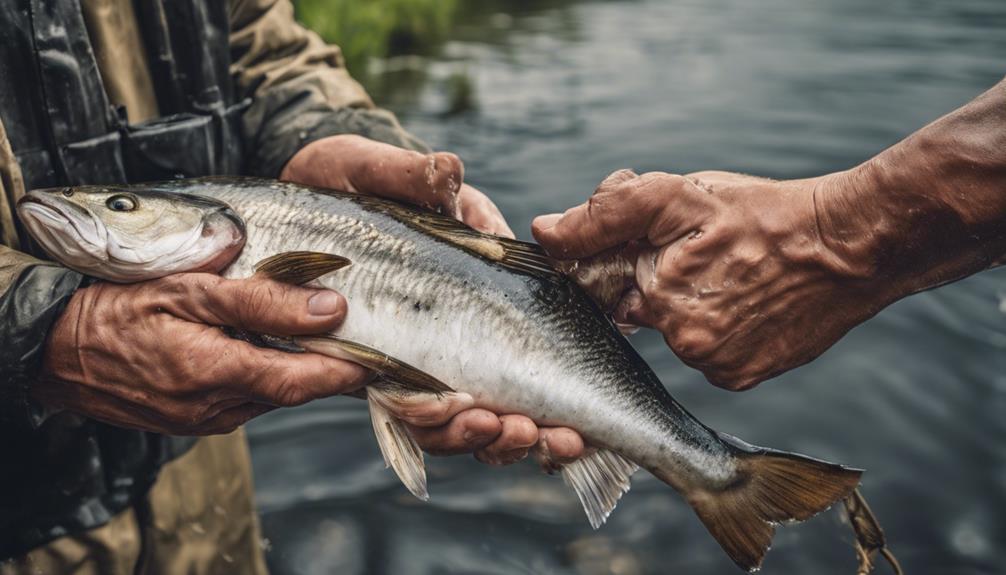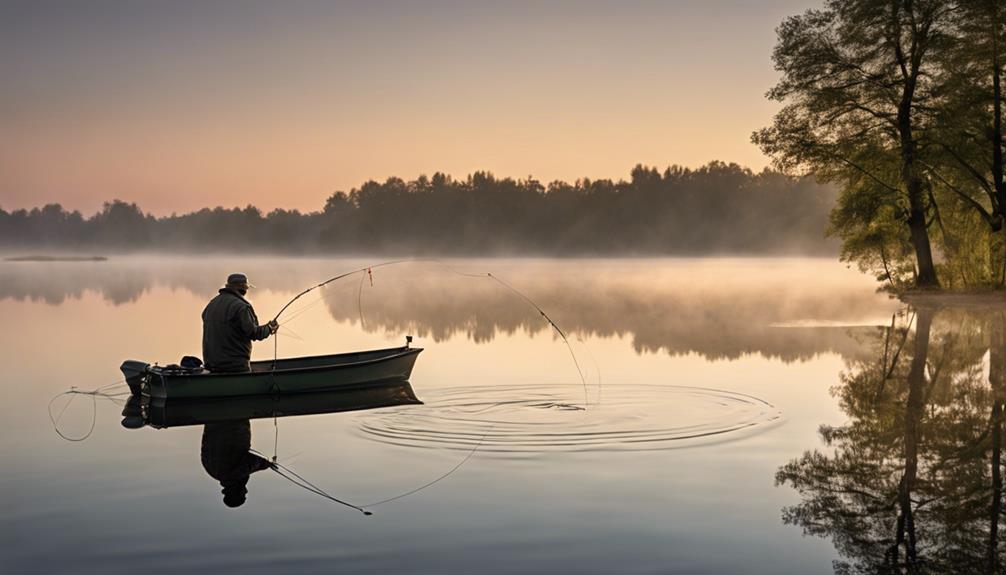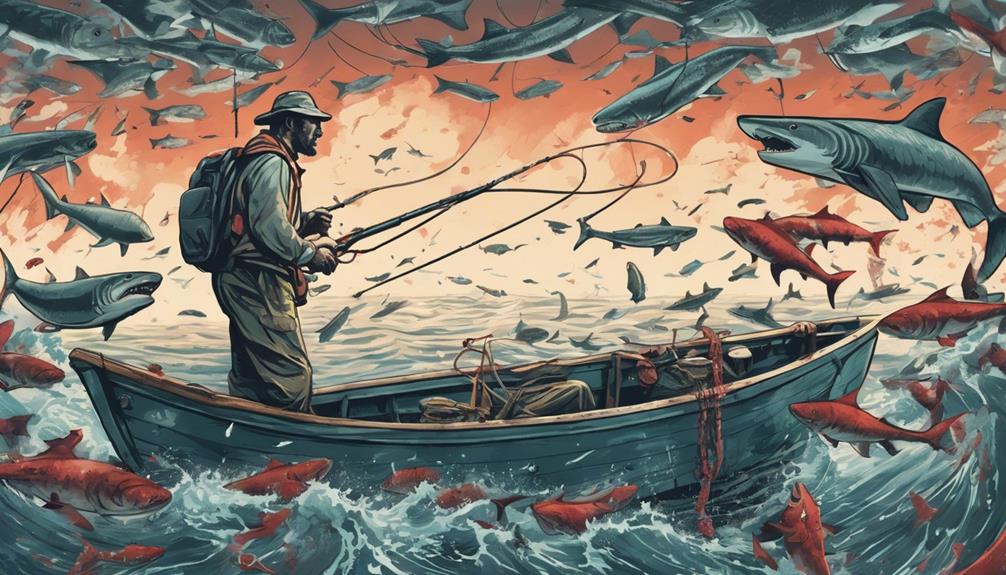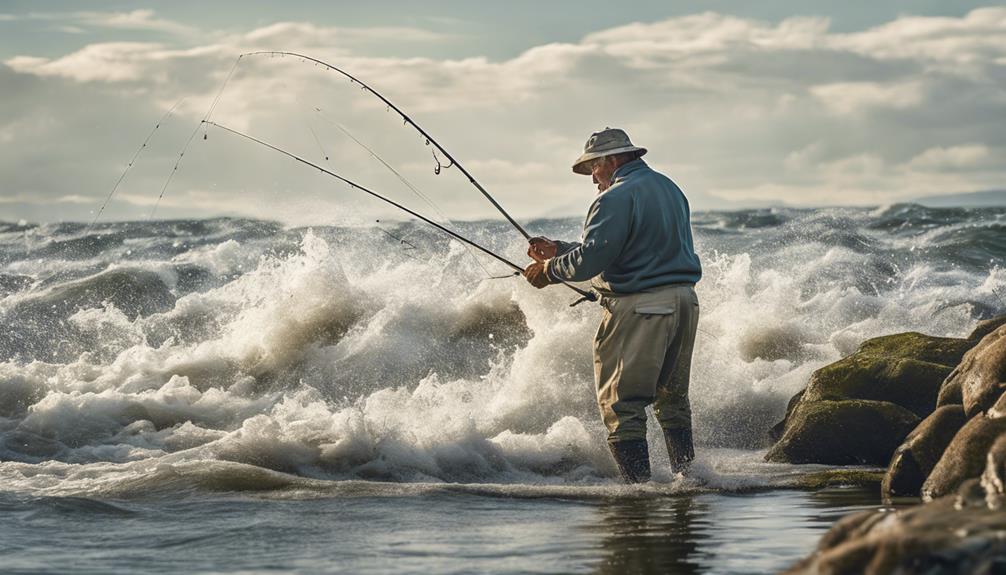Whether you're a seasoned angler or just starting out, mastering the art of river bank fishing can be both challenging and rewarding. Picture this: the serene tranquility of a flowing river juxtaposed with the thrill of feeling a sudden tug on your line.
But how can you ensure a successful catch every time? By employing the right techniques and strategies, you can increase your chances of landing that prized fish. Let's explore some key tips and tricks that will help you elevate your river bank fishing game to the next level.
Best Baits for River Bank Fishing
When fishing from the river bank, consider using live bait or artificial lures to increase your chances of catching fish. Lure selection is crucial in determining the type of fish you attract. Different species are enticed by various types of lures, so it's essential to choose the right one for your target. Artificial lures mimic the movement of prey, making them attractive to predatory fish. On the other hand, live bait such as worms, minnows, or insects can be irresistible to a wide range of fish species.
In terms of bait presentation, how you present your bait can significantly impact your success. When using artificial lures, focus on mimicking the natural movement of prey in the water. Vary your retrieval speed and experiment with different techniques to see what works best. For live bait, ensure it looks lively and natural in the water. Avoid using bait that looks dull or lifeless, as fish are less likely to be attracted to it. Properly hooking live bait is also crucial; make sure it stays on the hook securely and appears natural to the fish.
Optimal Casting Techniques
To enhance your river bank fishing experience and increase your chances of success, mastering optimal casting techniques is key. Precision casting and distance casting are crucial skills to hone. Precision casting involves accurately placing your lure or bait in specific spots, such as near structure or in feeding areas, increasing your chances of a successful catch. Distance casting, on the other hand, allows you to reach farther areas of the river, accessing more potential fishing spots.
Effective line management is also essential for successful river bank fishing. Properly managing your line ensures that it doesn't get tangled or caught on debris along the river bank, reducing the chances of losing your catch. Additionally, mastering the art of hook setting is vital. A strong and timely hook set is necessary to secure a good hook hold on the fish, increasing the likelihood of reeling it in successfully.
When casting from the river bank, remember to consider factors like wind direction and current flow to adjust your casting technique accordingly. Pay attention to your surroundings and make adjustments to your casting angle and strength to compensate for these variables. By practicing and perfecting these casting techniques, along with mastering line management and hook setting, you can significantly improve your river bank fishing success.
Understanding River Currents
Understanding river currents is crucial for successful river bank fishing, as they greatly influence the behavior and movement of fish in the water. When fishing in rivers, being aware of current patterns and water flow can significantly enhance your chances of making a catch.
Here are some key points to consider:
- Current Patterns: Rivers can have various current patterns, including slow-moving eddies, fast-flowing stretches, and deep pools. Understanding these patterns can help you position your bait effectively and anticipate where fish are likely to be.
- Water Flow: The speed and direction of water flow in a river can impact how fish position themselves to conserve energy while feeding. Fish often hold behind obstacles like rocks or logs to avoid strong currents, so casting your line near these structures can yield better results.
- Eddies and Back Eddies: Eddies are circular currents that form behind obstructions, creating calmer areas where fish may gather. Back eddies, on the other hand, flow in the opposite direction of the main current and can be productive spots to target.
- Current Seams: Current seams are the transition zones between different water speeds. Fish often patrol along these seams to feed on drifting insects or baitfish. By casting your lure along these seams, you can present your bait in a natural way and attract more bites.
Selecting the Right Gear
Choosing the appropriate gear is essential for optimizing your river bank fishing experience and increasing your chances of a successful catch. When it comes to gear maintenance, ensure your equipment is clean and in good working condition before heading out. Regularly check your rods, reels, and lines for any signs of wear and tear, and make necessary repairs or replacements to avoid any issues while fishing.
For rod selection, consider the type of fish you're targeting and the size of the river. A medium to medium-heavy rod is versatile and suitable for a wide range of fish species commonly found in rivers. Opt for a rod length between 6 to 7.5 feet for better control and casting accuracy from the river bank. Pair your rod with a reel that matches its weight and line capacity to achieve a balanced setup.
When it comes to gear maintenance, remember to clean your equipment after each fishing trip to prevent corrosion and prolong its lifespan. Store your gear in a cool, dry place to avoid any damage from humidity or extreme temperatures. By selecting the right gear and maintaining it properly, you can enhance your river bank fishing experience and increase your chances of landing that prized catch.
Strategic Spot Selection
Consider the river's flow and structure when scouting for strategic fishing spots along the bank. To maximize your chances of a successful fishing trip, keep the following tips in mind:
- Bank Access: Look for areas where you can easily access the bank to set up your fishing spot. Having convenient access will save you time and effort, allowing you to focus on fishing.
- Wading Options: Explore the riverbank for potential wading opportunities. Being able to wade into the water opens up more fishing possibilities and can help you reach areas that are otherwise inaccessible from the bank.
- Rod Positioning: Position yourself in a way that allows for smooth casting and easy maneuvering. Consider the surrounding obstacles and adjust your rod position accordingly to avoid tangles and ensure a better fishing experience.
- Line Management: Pay attention to how you manage your fishing line to prevent snags and ensure efficient bait presentation. Keep your line clear of debris and adjust the tension based on the current flow to increase your chances of a successful catch.
Weather Considerations
When planning your river bank fishing expedition, always factor in the current weather conditions to enhance your angling success. Rain gear essentials are crucial for ensuring you stay dry and comfortable during unexpected showers. Packing a waterproof jacket, pants, and even extra socks can make a significant difference in your overall experience. Additionally, keeping a waterproof bag for your electronics and valuables can save you from potential damage.
Another important consideration is the impact of wind direction on your fishing trip. Wind can significantly affect the behavior of fish, as it influences the distribution of food sources and creates underwater currents. Understanding how wind direction impacts the area where you plan to fish can help you position yourself strategically to increase your chances of a successful catch. For example, fish tend to gather on the leeward side of the water body, as the wind pushes food in that direction.
Handling Fish Properly

To ensure the well-being of the fish you catch, handle them properly to maximize their chances of survival after release. Proper handling and fish release techniques are crucial skills for any angler. Here are some essential tips to help you handle fish properly:
- Minimize Air Exposure: Limit the time a fish spends out of the water to prevent stress and injury to their gills.
- Use Wet Hands or Gloves: Wet your hands or wear gloves to protect the fish's slime layer, which is essential for their protection against infections.
- Avoid Dropping Fish: Handle fish gently and avoid dropping them, as this can cause internal injuries.
- Support the Fish: Always support the fish horizontally to avoid damage to their internal organs and spine.
Safety Tips for River Anglers
Wondering how you can ensure your safety while fishing along river banks? Safety is paramount when engaging in river angling. One crucial aspect to consider is emergency preparedness. Always inform someone about your fishing location and expected return time. Carrying a fully charged phone and a first aid kit can be lifesaving in case of accidents. Additionally, knowing the nearest emergency services contact details is essential. When angling in remote areas, consider taking a personal locator beacon for added safety.
Another vital safety concern for river anglers is wildlife encounters. While observing wildlife can be exciting, it's important to do so from a safe distance. Be cautious of snakes, bears, or other potentially dangerous animals that may inhabit the area. Familiarize yourself with the local wildlife and how to react if you encounter them. Avoid feeding wildlife as it can attract unwanted attention and potentially dangerous situations.
Frequently Asked Questions
How Can I Effectively Use Live Bait for River Bank Fishing?
When fishing from the river bank, using live bait effectively involves mastering bait presentation and selecting the right hook size. Consider the water depth and cast your line to an appropriate distance.
Ensure the bait looks natural in the water to attract fish. Experiment with different bait sizes and types to see what the fish prefer. By adjusting these factors, you can increase your chances of a successful catch.
What Are Some Common Mistakes to Avoid When Casting From the River Bank?
When casting from the river bank, it's important to avoid common mistakes that can spook fish. Pay attention to proper casting techniques to prevent scaring away potential catches. Understand fish behavior to know where to aim your casts.
Keep your movements quiet and smooth to maintain a low profile and increase your chances of hooking a fish. By being mindful of these factors, you can improve your success rate when fishing from the river bank.
Are There Any Specific Techniques for Fishing in Shallow Vs. Deep River Currents?
When fishing in shallow vs. deep river currents, current analysis and depth perception are key. Understanding the flow and water depth helps you choose the right tackle and casting techniques.
In shallow waters, use lighter tackle and focus on precision casting near structures. For deep currents, opt for heavier tackle to reach the bottom and fish along drop-offs. Adjust your techniques based on the specific conditions to maximize your chances of catching fish.
How Can I Properly Maintain and Care for My Fishing Gear Used for River Bank Fishing?
To keep your fishing gear in top shape for river bank fishing, remember proper maintenance is key. Store your equipment in a dry place to prevent rust and damage.
Regularly clean your gear after each use to remove dirt and debris. Check for any signs of wear and tear, and make necessary repairs promptly.
What Are Some Ways to Predict Fish Behavior Based on Weather Patterns When Fishing From the River Bank?
When fishing from the river bank, predicting fish behavior based on weather patterns is key. Pay attention to temperature changes and how they correlate with fish activity. Weather indicators like barometric pressure can impact feeding patterns.
Warmer temperatures may lead to more active fish, while cold fronts could slow them down. By observing these cues, you can improve your chances of a successful fishing trip.
Conclusion
In conclusion, mastering effective techniques for river bank fishing can greatly increase your chances of success. By using the right bait, casting techniques, understanding currents, selecting appropriate gear, choosing strategic spots, considering weather conditions, handling fish properly, and prioritizing safety, you can enhance your overall fishing experience.
Remember to always stay prepared and adaptable to the changing conditions of the river to maximize your fishing opportunities. Happy fishing!



